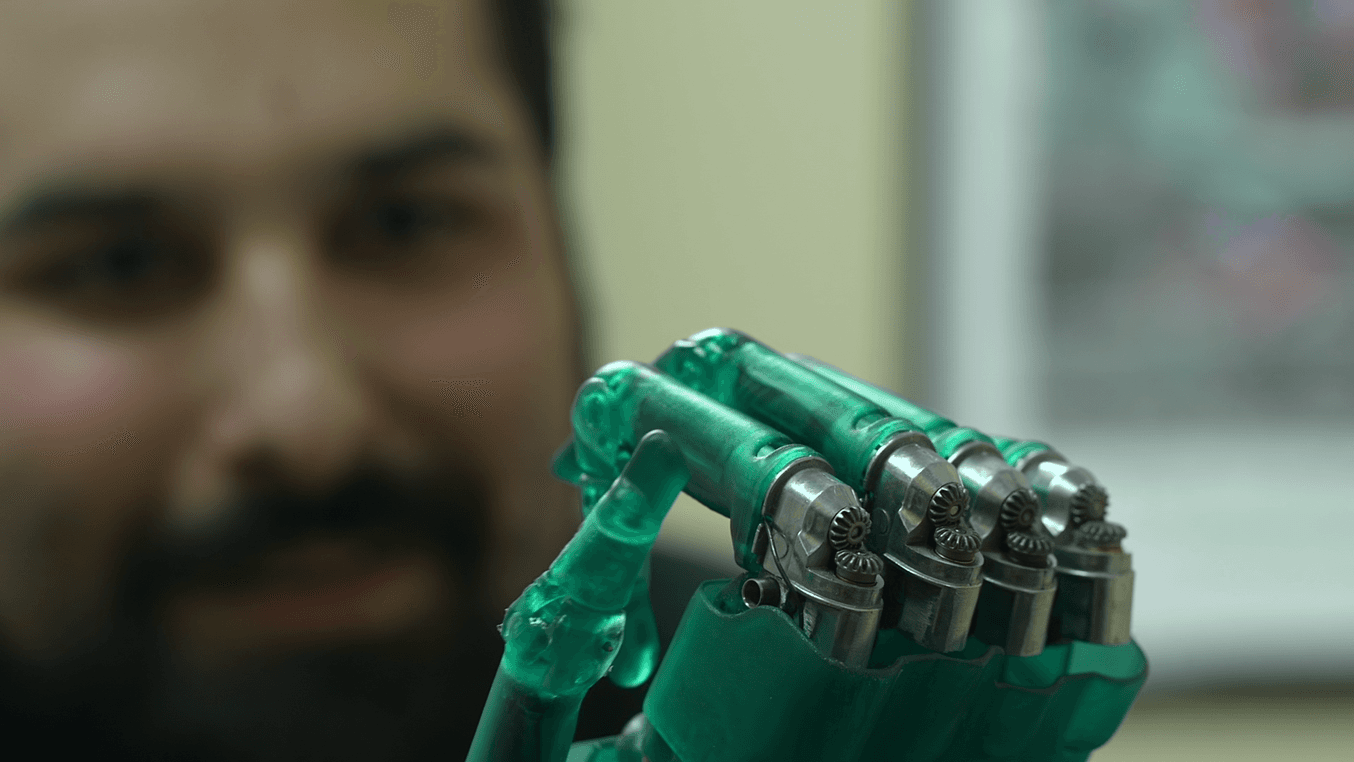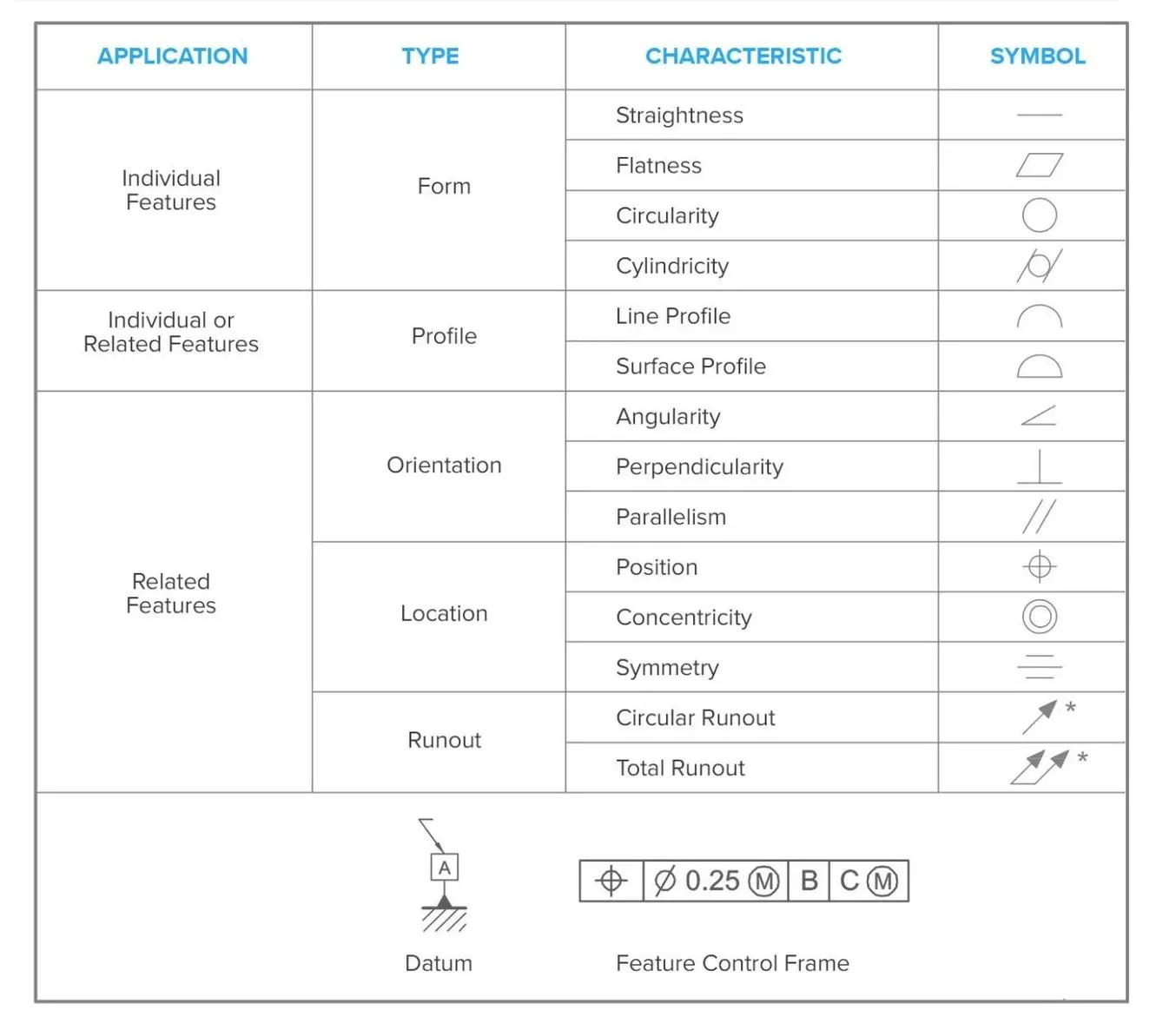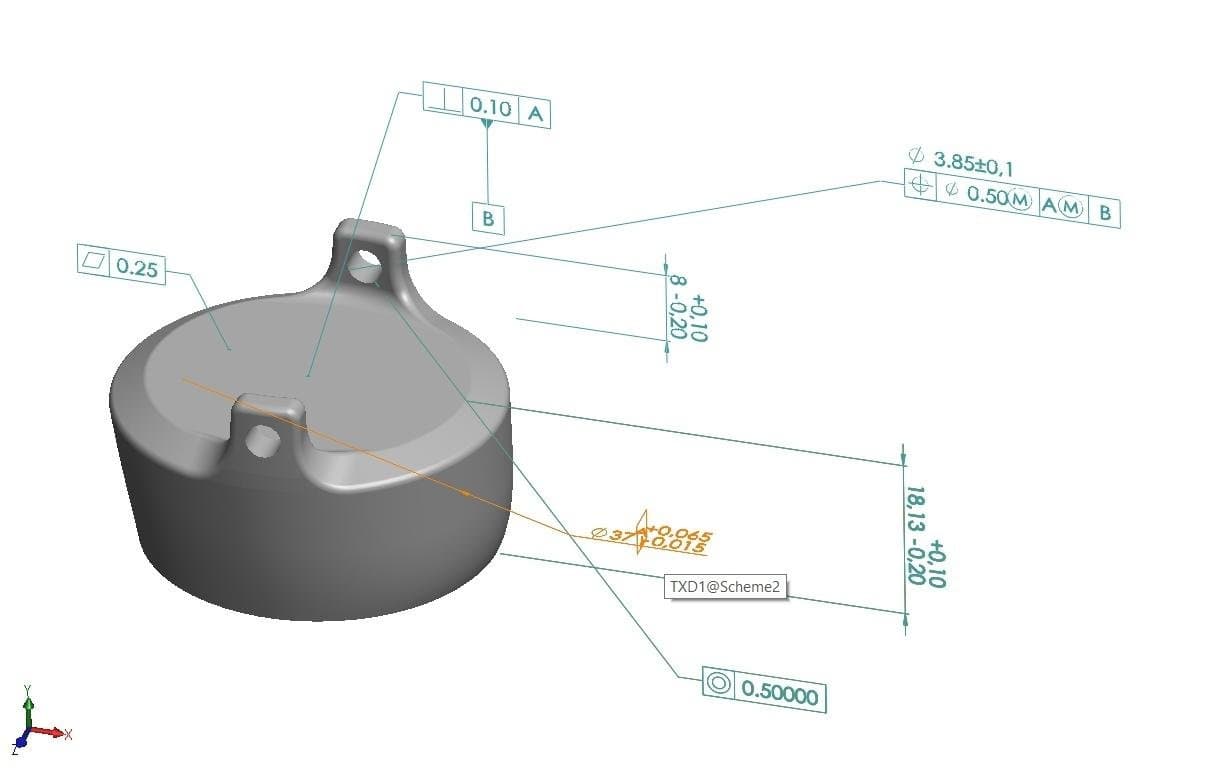How to Read Profile Tolerances on a Sheet Metal Part
Before GD&T, manufacturing features were specified by X-Y areas. For case, when drilling a mounting hole, the hole had to exist inside a specified X-Y area.
An accurate tolerancing specification, however, would define the position of the hole in relation to the intended position, the accepted area being a circle. X-Y tolerancing leaves a zone in which inspection would have produced a imitation negative considering while the hole is not within the 10-Y square, it would fall within the circumscribed circumvolve.
Stanley Parker, an engineer who was developing naval weapons during World War Ii, noticed this failure in 1940. Driven by the need for toll-constructive manufacturing and coming together deadlines, he worked out a new system through several publications. Once proven as a better operational method, the new system became a military standard in the 1950s.
Currently, the GD&T standard is defined past the American Club of Mechanical Engineers (ASME Y14.5-2018) for the The states and ISO 1101-2017 for the balance of the world. It concerns mostly the overall geometry of the product, while other standards describe specific features such as surface roughness, texture, and screw threads.
With functional assemblies, multi-role products, or parts with complex functionality, it is crucial that all components work well together. All relevant fits and features need to be specified in a fashion that impacts the manufacturing procedure and its related investments the least, while still guaranteeing functionality. Tightening tolerances by a factor two tin can raise the costs twofold or even more, due to higher reject rates and tooling changes. GD&T is the organization that allows developers and inspectors to optimize functionality without increasing cost.
The most important do good of GD&T is that the organization describes the blueprint intent rather than the resulting geometry itself. Like a vector or formula, it is not the bodily object but a representation of information technology.
For instance, a feature standing at xc degrees to a base of operations surface tin can be toleranced on its perpendicularity to that surface. This will define two planes spaced apart, that the center airplane of the characteristic must fall within. Or, when drilling a pigsty, it makes the most sense to tolerance it in terms of alignment to other features.
Describing product geometry related to its intended functionality and manufacturing approach is ultimately simpler than having to describe everything in linear dimensions. It as well provides a communication tool with manufacturing vendors, customers, as well as quality inspectors.
When performed well, GD&T even allows statistical process control (SPC), reducing product turn down rates, associates failures, and the effort needed for quality control, saving organizations substantial resource. As a event, multiple departments are able to piece of work more in parallel because they have a shared vision and linguistic communication for what they want to achieve.
Engineering drawings demand to show the dimensions for all features of a part. Next to the dimensions, a tolerance value needs to exist specified with the minimum and maximum adequate limit. The tolerance is the deviation between the minimum and maximum limit. For example, if nosotros have a table that nosotros would accept with a tiptop betwixt 750 mm and 780 mm, the tolerance would be 30 mm.
However, the tolerance for the table implies that we would accept a tabular array that is 750 mm high on one side and 780 mm on the other, or has a waved surface with 30 mm variation. So to appropriately tolerance the product, we need a symbol communicating the pattern intent of a flat height surface. Therefore we have to include an additional flatness tolerance in addition to the overall height tolerance.

Parts with unpredictable variations and circuitous shapes crave GD&T practices beyond simple plus-minus tolerancing.
Similarly, a cylinder with a toleranced diameter will not necessarily fit into its hole if the cylinder gets slightly bent during the manufacturing process. Therefore it too needs a straightness control, which would be difficult to communicate with traditional plus-minus tolerancing. Or a tube that has to seamlessly match a complex surface that it'due south welded to requires a surface profile control.
GD&T establishes a library of symbols to convey such design intents, which we discuss in the post-obit department.

Dynamic assemblies such as this prosthetic mitt require precise tolerancing.
The art of tolerancing means to specify only the right variations for all specific blueprint features in order to maximize product approval rate inside the limits of the manufacturing processes and depending on the function's visual and functional purpose.
In the metric organization, there are International Tolerance (IT) grades that can also be used to specify tolerances by ways of symbols. The symbol 40H11, for example, means a xl mm bore hole with a loose running fit. The manufacturer so only needs to await up the basis table for hole features to derive the exact tolerance value.
Besides individual tolerances, engineers must take into business relationship system-level effects. For example, when a office comes out with all dimensions at their maximum allowed value, does it still meet overall requirements such as product weight and wall thicknesses? This is called the Maximum Cloth Condition (MMC), while its counterpart is the To the lowest degree Material Condition (LMC).
Tolerances besides stack up. If we create a concatenation link where each hole has a 0.1 mm plus tolerance and each shaft a 0.1 mm negative tolerance, that ways we will still have a twenty mm length departure at 100 links. When installing repeated elements such as a perforated hole design, showtime position the pattern then specify interrelated distances rather than referencing elements to a stock-still border or aeroplane of the part.
The standards do not only pertain to designers and engineers but also to quality inspectors by informing them how to measure the dimensions and tolerances. Using specific tools such every bit digital micrometers and calipers, height gauges, surface plates, dial indicators, and a coordinate measuring car (CMM) are important to tolerancing practice.
When measuring and defining a office, the geometry exists in a conceptual space called the Datum Reference Frame (DRF). This is comparable to the coordinate system at the origin of a infinite in 3D modeling programs. A datum is a betoken, line or plane that exists in the DRF and is used as a starting place for measuring. Make certain to ascertain the datum features relevant to the functionality of your part. Unless you are mating features of 1 part to those of others in an assembly, you tin can oftentimes use a single datum. Always brand sure that the primary datum has a reliable location to derive other measurements from, for case, where the last part will accept little unpredictable variation.
An engineering drawing has to accurately convey the product without calculation unnecessary complexity or restrictions. The following guidelines are helpful to consider:
-
Clarity of a drawing is the most important, even more then than its accurateness and abyss. To improve clarity, draw dimensions and tolerances outside of the role's boundaries and practical to visible lines in true profiles, employ a unidirectional reading direction, convey the role of the role, group and/or stagger dimensions, and make use of white space.
-
Always design for the loosest viable tolerance to go on costs downwards.
-
Utilize a general tolerance divers at the lesser of the drawing for all dimensions of the part. Specific tighter or looser tolerances indicated in the drawing volition and then supersede the full general tolerance.
-
Tolerance functional features and their interrelations first, then motion on to the rest of the part.
-
Whenever possible, leave GD&T work to the manufacturing experts and practise not depict manufacturing processes in the engineering science cartoon.
-
Practise not specify a ninety-degree angle since it is assumed.
-
Dimensions and tolerances are valid at 20 °C / 101.3 kPa unless stated otherwise.
GD&T is feature-based, with each characteristic specified past different controls. These tolerancing symbols fall into five groups:
-
Form controls specify the shape of features, including:
-
Straightness is divided into line element straightness and centrality straightness.
-
Flatness means straightness in multiple dimensions, measured between the highest and lowest points on a surface.
-
Circularity or roundness can exist described as straightness bent into a circle.
-
Cylindricity is basically flatness bent into a barrel. Information technology includes straightness, roundness, and taper, which makes it expensive to inspect.
-
-
Profile controls describe the three-dimensional tolerance zone around a surface:
-
Line Contour compares a two-dimensional cross-section to an ideal shape. The tolerance zone is defined by two offset curves unless otherwise specified.
-
Surface Profile creates through two offset surfaces between which the feature surface must fall. This is a complex control typically measured with a CMM.
-
-
Orientation controls business organisation dimensions that vary at angles, including:
-
Angularity is flatness at an angle to a datum and is also adamant through 2 reference planes spaced the tolerance value apart.
-
Perpendicularity ways flatness at 90 degrees to a datum. It specifies ii perfect planes the feature airplane must lie in between.
-
Parallelism ways straightness at a distance. Parallelism for axes can exist defined by defining a cylindrical tolerance zone by placing a diameter symbol in front of the tolerance value.
-
-
Location controls define characteristic locations using linear dimensions:
-
Position is the location of features relative to one another or to datums and is the almost used control.
-
Concentricity compares the location of a characteristic axis to the datum axis.
-
Symmetry ensures that not-cylindrical parts are similar across a datum plane. This is a complex control typically measured with a CMM.
-
-
Runout controls define the amount by which a particular feature can vary with respect to the datums:
-
Circular Runout is used when in that location is a demand to account for many dissimilar errors, such every bit brawl-begetting mounted parts. During inspection, the part is rotated on a spindle to measure the variation or 'wobble' around the rotational centrality.
-
Full Runout is measured on multiple points of a surface, not just describing the runout of a round feature but of an entire surface. This controls straightness, profile, angularity, and other variations.
-

Both ANSI and ISO standards use these common symbols for tolerancing controls.

The Characteristic Control Frame is the notation to add controls to the cartoon. The leftmost compartment contains the geometric characteristic. In the instance to a higher place, it is a location command just it tin can comprise any of the command symbols. The kickoff symbol in the second compartment indicates the shape of the tolerance zone. In this instance, it is a bore as opposed to a linear dimension. The number indicates the allowed tolerance.
Next to the tolerance box, there are separate boxes for each datum feature that the control refers to. Hither, the location volition be measured related to datum B and C. Next to the tolerance or a datum feature is an optional encircled letter, the feature modifier.
The post-obit possibilities can occur:
-
M means that the tolerance applies in the Maximum Material Status (MMC)
-
Fifty means that the tolerance applies in the To the lowest degree Material Condition (LMC)
-
U indicates an unequal bilateral tolerance, i.e. for a 1 mm tolerance it may specify it as minus 0.20 and plus 0.80.
-
P means that the tolerance is measured in a Projected Tolerance Zone at a specified altitude from the datum.
-
No symbol installs the tolerance regardless of feature size (RFS)
For this case, if the role is not in MMC, a bonus tolerance tin can be added proportionally to the difference from MMC. And so if a part is at 90% MMC, the tolerance will also loosen by 10%.
Many production designers and engineers use 3D printing during prototyping and product evolution to produce cost-effective prototypes and custom parts that would otherwise require significant investment in tooling.
Tolerancing in 3D printing differs from traditional manufacturing tools because 3D printing is a single automated process. Tighter tolerances may require more try in the pattern stage, just can yield meaning time and costs savings in prototyping and product.
Most CAD tools aimed at mechanical engineering science such as SolidWorks, Autodesk Fusion 360, AutoCAD, SolidEdge, FreeCAD, CATIA, NX, Creo, and Inventor offer GD&T integration when creating engineering drawings. Withal, designers still have to install tolerances manually, taking into business relationship the possible deviations that occur during the manufacturing procedure. In the following example written report, we prove an example of GD&T in apply in SolidWorks.
This specific project aims to produce l,000 bottle caps through injection molding. We want to control the feel and force with which the caps volition fit onto the bottle and therefore require good tolerancing specification. Nosotros want to forestall that some caps are larger in outer bore than the bottle, while others are smaller, and retain a consequent running fit instead.
The bottle's thread has an outer diameter of 36.95 +/- 0.010 mm. That means the limits of the cap's inner diameter are 36.985 and 37.065 mm, with a mean value of 37.0 mm.
The cap likewise has specific hole connections to an axle that is mounted underneath a flat surface. This allows the bottle to be opened with one paw while information technology hangs underneath the surface of a storage chiffonier. The beam is a standard OEM stainless steel component with a 4mm diameter and 0.13mm (0.005") tolerance. For a snug connection, we require a force fit with an assart between -0.0375 and 0.0125 mm. Here we detect a range of 3.99 to four.01 mm for the hole diameter that results in a force fit for all axle sizes. Because this is such a narrow range nosotros decide to specify the hole at 3.85 mm and so drill information technology to an verbal 4.00 mm which besides controls concentricity of the 2 holes.

This cap with multiple mating features requires Geometric Dimensioning and Tolerancing.
To control our dimensions properly, nosotros need to make apply of a datum. A datum needs to represent mating features and function of the assembly, plus it needs to be stable, repeatable, and attainable. In this case, the mating of the cap and bottleneck are most important, then we cull the cap's inner cylindrical surface as the chief datum. The secondary function is the mating with the mounting surface, and then nosotros pick the apartment top of the cap equally the secondary datum.
Afterward considering the requirement, implementing GD&T tolerancing in Solidworks works as follows. Indicate the datums in DimXpert > Auto Dimension Scheme and select the Geometric option as opposed to Plus/Minus tolerancing. And so select the datums and features to command based on the datums. With the Dimension Scheme completed, add individual Geometric Tolerances and GD&T symbols. The software automatically generates dimensions for features-of-size (FOS), such every bit holes and bosses. Make sure to select 'bilateral' or 'limit' as tolerance type for features where the plus and minus limit are unequal.


Selecting datums and features for Geometric Tolerancing in Solidworks.
To import these tolerances into an engineering drawing, first, check the FeatureManager for which planes are used in the 'Annotations' folder. When importing the views from these planes into a drawing, check 'Import annotations' and 'DimXpert annotations'. Adding an appropriate section view will greatly clarify the cartoon.

A properly toleranced manufacturing drawing.
In this guide, nosotros accept discussed the system of Geometric Dimensioning and Tolerancing (GD&T), which brings tremendous benefits for designers and engineers working on circuitous products where dimensions demand to exist tightly controlled. We have seen how GD&T conveys not only linear dimensions but also design intent, which helps communicate the engineering design more than clearly to project stakeholders.
With simply over a dozen symbols, the datum characteristic, and characteristic control frame, information technology is possible to highly enrich product drawings and ensure that engineering fits remain consequent across product assemblies. GD&T likewise invites developers to think near how to optimally tolerance their parts for the chosen manufacturing process, since dissimilar production techniques bring along different characteristic deviations.
Companies across aerospace, automotive, defense, consumer appurtenances, medical, and more are adopting digital manufacturing tools to have steps towards the promise of Industry 4.0. 3D press is a catalyst for efficiency, giving staff from product engineer to machinist the tools to tighten supply bondage, amend product, and get to marketplace faster—saving hundreds of thousands of dollars and weeks to months of time forth the way.
Learn more well-nigh how leading manufacturers like Ford, General Electric, and Dyson leverage 3D press to save money and shorten lead times from pattern to product.
Source: https://formlabs.com/asia/blog/gdt-geometric-dimensioning-and-tolerancing/
0 Response to "How to Read Profile Tolerances on a Sheet Metal Part"
Post a Comment